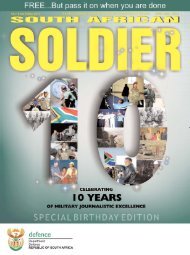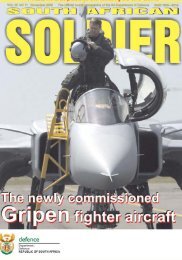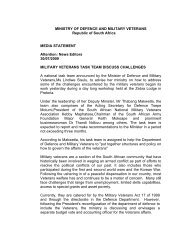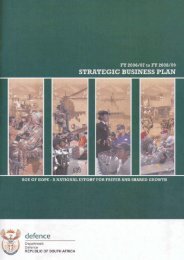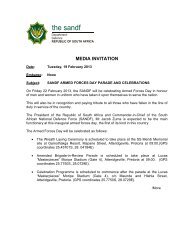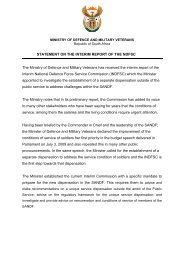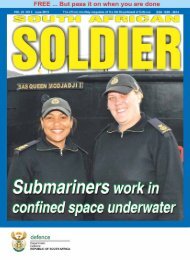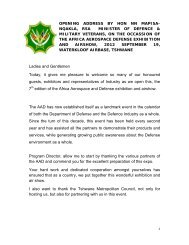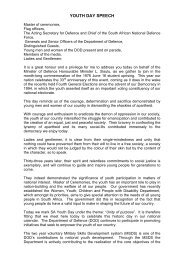annrep 1011 1 to 148.qxp - Department of Defence
annrep 1011 1 to 148.qxp - Department of Defence
annrep 1011 1 to 148.qxp - Department of Defence
You also want an ePaper? Increase the reach of your titles
YUMPU automatically turns print PDFs into web optimized ePapers that Google loves.
D E P A R T M E N T O F D E F E N C E<strong>Department</strong> <strong>of</strong> <strong>Defence</strong> and Military VeteransVote 21REPORT OF THE ACCOUNTING OFFICERfor the year ended 31 March 20111.1.1.5 Provision <strong>of</strong> skills1.1.1.5.1 The Military Skills Development System (MSDS) was implemented in January 2003 with the aim <strong>of</strong> providing theSANDF with military human resources as required for force preparation and force employment specifications. Itforms the DOD's primary contribution <strong>to</strong> youth development. The MSDS also alleviates unemployment and povertyby preparing young people between the age <strong>of</strong> 18 and 26 years for rewarding careers either in the SANDF or for decentemployment in the broader public and private sec<strong>to</strong>rs. The MSDS is a two-year contract based service system and isthe main feeder system for the Regular Force and Reserves. The MSDS has the following goals:The system inducts new members in<strong>to</strong> the SANDF.It equips members with basic military skills and functional training for service in the military.It evaluates member's development potential and suitability for continued services in the Regular Force andReserves.It tests members so that the organisation can choose individuals for a possible continued career in the military.It ensures a sufficiently trained pool <strong>of</strong> young and fit members <strong>to</strong> fulfil the SANDF's deployment needs.It feeds the Reserves with trained troops and junior leaders.Is the primary vehicle <strong>to</strong> rejuvenate the SANDF's Human Resource composition (Regular Force and Reserves)<strong>to</strong> improve mission readiness and <strong>to</strong> grant development opportunities <strong>to</strong> the youth.1.1.1.5.2 Since the inception <strong>of</strong> the MSDS, 33 536 youths joined the employment system <strong>of</strong> the SANDF. Of the <strong>to</strong>tal intake,8 542 are currently serving in the MSDS, 6 770 have separated from the SANDF (<strong>of</strong> whom 4 821 are serving in theReserves) and 18 224 translated <strong>to</strong> the Regular Forces where they are undergoing advanced training in various disciplinesand are being utilised accordingly.1.1.1.5.3 The results <strong>of</strong> implementing the MSDS are best viewed from the vantage point <strong>of</strong> rank-age compliance: only 10.8%<strong>of</strong> Privates were in the age group 18 <strong>to</strong> 24 years old in the year 2000 compared <strong>to</strong> 55% currently.1.1.1.5.4 The MSDS also is a feeder system, at entry levels, <strong>of</strong> scarce skills and critical musterings. Since its inception, 6 172youths have been employed in critical musterings i.e. air space control, aircrew, combat navy, engineer, medical pr<strong>of</strong>essional,nursing, technical and technical air. Therefore, the MSDS significantly contributes, at entry level, <strong>to</strong> the sustainmen<strong>to</strong>f scarce skills and critical musterings.1.1.1.5.5 The young men and women who emerge after MSDS service are on the whole much more mature, disciplined, servicedelivery orientated, career orientated and patriotic than one would normally expect from young people who havejust completed high-school. Through the MSDS, the SANDF continues <strong>to</strong> invest directly in South Africa's mostimportant asset, our youth. In support <strong>of</strong> the government initiative on job creation, the DOD plans <strong>to</strong> create job opportunitiesfor 5 700 young South Africans per year through the MSDS.1.1.1.6 Border Safeguarding. As per the 2009 Cabinet decision, the SANDF has assumed the borderline control function.In execution <strong>of</strong> this task under Operation CORONA, the SANDF has adopted a phased-in strategy. The first phase(Zimbabwe/South Africa border) and the second phase (Mozambique/South Africa border) has been rolled out. Thelast phase <strong>of</strong> the strategy with regards <strong>to</strong> the Lesotho/South Africa border will be completed by the financial year2012/13.1.1.1.7 <strong>Defence</strong> Industry.1.1.1.7.1 ARMSCOR and DENEL are central in this regard. Armscor is established in terms <strong>of</strong> applicable legislation <strong>to</strong> serveas the acquisition agency <strong>of</strong> the DOD. Because <strong>of</strong> this role, ARMSCOR is a critical stakeholder in so far as theSANDF's operational effectiveness is concerned. As the agency serving the DOD, ARMSCOR falls under the juris-154ANNUAL REPORT FY 2010/2011



